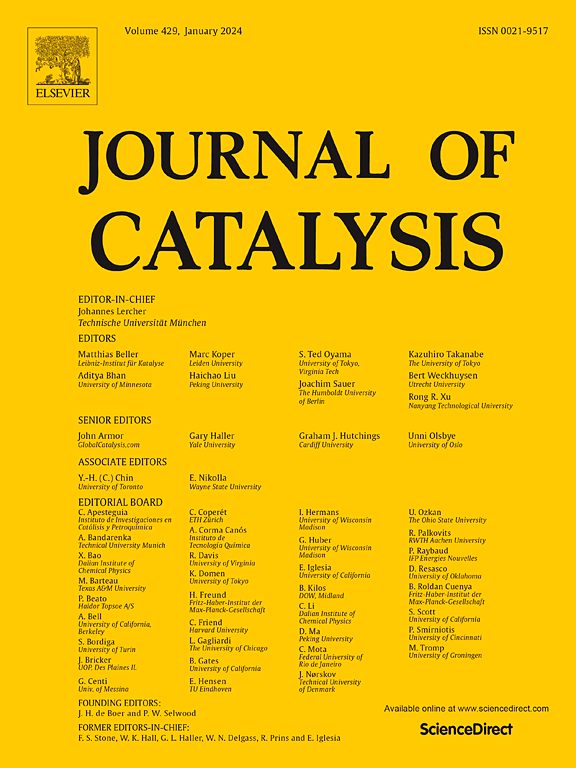Mechanistic insights into nitrate electroreduction on CuNi alloys: d-band center modulation of key intermediates
IF 6.5
1区 化学
Q2 CHEMISTRY, PHYSICAL
引用次数: 0
Abstract
Electrochemical nitrate reduction reaction to ammonia (NO3RR) is a promising alternative to the traditional Haber-Bosch process for NH3 synthesis. The development of efficient electrocatalysts is crucial for this process. Copper-nickel alloy (CuNi) catalysts demonstrate excellent catalytic performance over pristine copper (Cu) and pristine nickel (Ni) catalysts, and it is noted that Ni incorporation significantly improves nitrate removal efficiency while suppressing undesirable nitrite formation for NO3RR. However, the reaction mechanism of NO3RR on CuNi catalysts remains unclear, particularly regarding the role of Ni incorporation. In this study, constant-potential method calculations were applied to CuNi(1 1 1) catalysts (Cu3Ni1(1 1 1), Cu2Ni2(1 1 1), and Cu1Ni3(1 1 1) with Cu:Ni atomic ratios of 3:1, 1:1, and 1:3, respectively) to understand their enhanced NO3RR performance compared to pristine Cu(1 1 1) and pristine Ni(1 1 1) catalysts. The potential-dependent adsorption energetics reveal the enhanced co-adsorption of NO3* and H* facilitates nitrate deoxidation-protonation and improves Faradic efficiency, while the strengthened NO2* binding simultaneously promotes its further reduction rather than desorption. Microkinetic analyses identify the dominant surface intermediates, and the simulated NH3 formation current densities exhibit highly consistent with experimental trends. Furthermore, the electronic structure analyses elucidate that the d-band center, optimized near Cu:Ni = 1:1, modulates the binding strengths of key intermediates and reduces activation barriers, thereby suppressing nitrite formation while promoting selective ammonia formation. These fundamental insights not only rationalize previously reported experimental phenomena but also provide design principles for developing efficient NO3RR electrocatalysts.


CuNi合金中硝酸盐电还原的机理:关键中间体的d波段中心调制
电化学硝酸还原反应制氨(NO3RR)是替代传统Haber-Bosch法合成NH3的一种很有前途的方法。高效电催化剂的开发是这一过程的关键。铜镍合金(CuNi)催化剂比原始铜(Cu)和原始镍(Ni)催化剂表现出优异的催化性能,并且Ni的加入显著提高了硝酸盐的去除效率,同时抑制了NO3RR中不良亚硝酸盐的形成。然而,NO3RR在CuNi催化剂上的反应机理尚不清楚,特别是Ni掺入的作用。在这项研究中,定压方法计算是应用于CuNi(1 1 1)催化剂(Cu3Ni1(1 1 1)Cu2Ni2(1 1 1),和Cu1Ni3(1 1 1)铜:镍原子比率3:1,1:1,1:3,分别)理解他们增强NO3RR性能相比原始铜(1 1 1)和原始镍(1 1 1)催化剂。电位依赖的吸附能量学表明,NO3*和H*的共吸附增强有利于硝酸盐脱氧质子化,提高了Faradic效率,而NO2*结合的增强同时促进了其进一步还原而不是解吸。微动力学分析确定了主要的表面中间体,模拟的NH3地层电流密度与实验趋势高度一致。此外,电子结构分析表明,在Cu:Ni = 1:1附近优化的d带中心调节了关键中间体的结合强度,降低了活化屏障,从而抑制了亚硝酸盐的形成,同时促进了选择性氨的形成。这些基本见解不仅使先前报道的实验现象合理化,而且为开发高效的NO3RR电催化剂提供了设计原则。
本文章由计算机程序翻译,如有差异,请以英文原文为准。
求助全文
约1分钟内获得全文
求助全文
来源期刊

Journal of Catalysis
工程技术-工程:化工
CiteScore
12.30
自引率
5.50%
发文量
447
审稿时长
31 days
期刊介绍:
The Journal of Catalysis publishes scholarly articles on both heterogeneous and homogeneous catalysis, covering a wide range of chemical transformations. These include various types of catalysis, such as those mediated by photons, plasmons, and electrons. The focus of the studies is to understand the relationship between catalytic function and the underlying chemical properties of surfaces and metal complexes.
The articles in the journal offer innovative concepts and explore the synthesis and kinetics of inorganic solids and homogeneous complexes. Furthermore, they discuss spectroscopic techniques for characterizing catalysts, investigate the interaction of probes and reacting species with catalysts, and employ theoretical methods.
The research presented in the journal should have direct relevance to the field of catalytic processes, addressing either fundamental aspects or applications of catalysis.
 求助内容:
求助内容: 应助结果提醒方式:
应助结果提醒方式:


